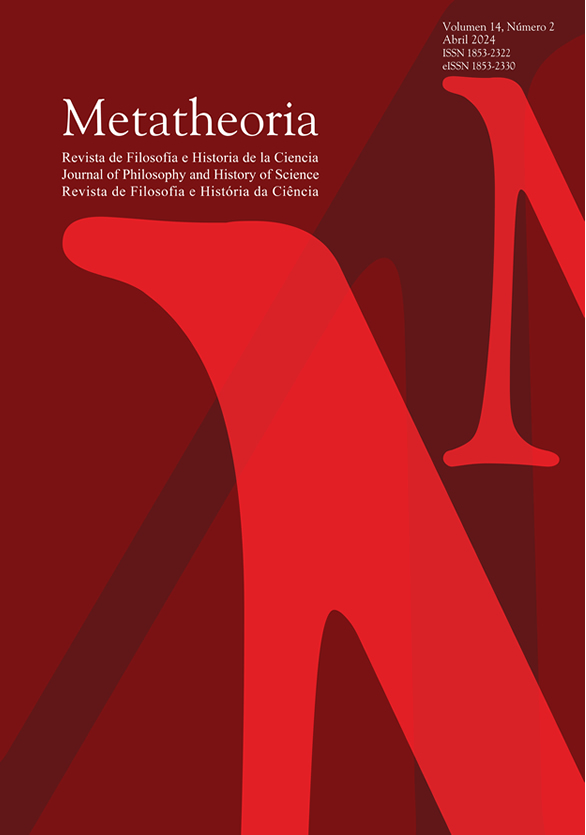Discursivities of Bioart and the Challenge of an Interspecies Methodology
DOI:
https://doi.org/10.48160/18532330me14.363Keywords:
semiotics, bioart, interspeciesAbstract
In La semiosis social 2 (2013), Eliseo Verón instrumentalizes biological metaphors to explain different trajectories that the spectators make during an exposition in the Pompidou Centre during 1984. If we think in recent museums of contemporary art, we can note at least three substantial changes in the elements that Verón used in his study. On one hand, the object in that case was analog photography. On the other hand, the characteristics of this object required an assembly strategy that responded to the logic of the modern museum. Finally, the conditions of reception respond to a circulation design of meaningful bodies. Faced with a consolidation of bioart as a field of poetic production with non-human species (López del Rincón 2015, Stubrin 2021), we ask ourselves in this article about the new methodological needs that semiotics could update by recovering contributions from the field of biosemiotics.
References
Álvarez Solís, A. (2023), “¿Puede escribir una planta? La crítica vegetal en la época de la extinción de la teoría”, Revista de teoría de la literatura y literatura comparada (29): 53-74. Disponible en: https://doi.org/10.1344/452f.2023.29.4
Braidotti, R. (2013), Lo posthumano, Madrid: Gedisa.
Haraway, D. (2016), “Antropoceno, Capitaloceno, Plantacionoceno, Chthuluceno: generando relaciones de parentesco” (trad. de Alexandra Navarro y María Marta Andreatta), Revista latinoamericana de estudios críticos animales III(1): 15-26.
Haraway, D. (2019), Seguir con el problema. Generar parentesco en el Chutuluceno, Madrid: Editorial Cactus.
Hauser, J. (2006), “Bio, techne, logos: un art très contemporain”, Inter: art actuel 94: 14-19. Disponible en: https://www.erudit.org/fr/revues/inter/2006-n94-inter1121523/45746ac.pdf
Lotman, Y. (1996), La semiosfera I. Semiótica de la cultura y del texto, Madrid: Ediciones Cátedra.
Kac, E. (1998), “El arte transgénico”, Leonardo Electronic Almanac 6(11). Disponible en: www.ekac.org/mecadkac.html
Kohn, E. (2021), Cómo piensan los bosques. Hacia una antropología más allá de lo humano, Buenos Aires: Abya Yala.
Kozak, C. (ed.) (2012), Tecnopoéticas argentinas: archivo blando y de arte y tecnología, 1ra ed., Buenos Aires: Caja Negra.
Kull, K. (2013), “Un signo no está vivo, el texto sí”, en Arrizabalaga, M. I. (ed.), Semiótica de la cultura, ecosemiótica y biorretórica, Córdoba: Facultad de Lenguas, Universidad Nacional de Córdoba, pp. 111-121.
Kull, K. (2016), “Ecosemiótica del arte: ¿puede la naturaleza ser embellecida?”, en Allora, J. y G. Calzadilla, Puerto Rican Light (Cueva Vientos), Nueva York: Dia Art Foundation, pp. 103-111.
López del Rincón, D. (2015), Bioarte: Arte y vida en la era de la biotecnología, Madrid: Akal.
Matewecki, N. (2022), “Pablo Logiovine, ganador en la categoría ‘Bioarte’ del Premio Itaú Artes Visuales 2022”, en Infobae, recuperado de: https://www.infobae.com/cultura/2022/06/10/pablo-logiovine-ganador-en-la-categoria-bioarte-del-premio-itau-artes-visuales-2022/
Mitchell, R. (2010), Bioart and the Vitality of Media, Seattle: University of Washington Press.
Page, J. (2023), Decolonial Ecologies. The Reinvention of Natural History in Latina American Art, Cambridge, UK: Open Book Publishers.
Peirce, C. S. (1986), La ciencia de la semiótica, Buenos Aires: Ediciones Nueva Visión.
Peirce, C. S. (1867), “Uno, dos, tres”, en Peirce, C. S., MS 721: 103-104. Disponible: https://www.unav.es/gep/UnoDosTres.html
Stubrin, L. (2021), Bioarte: poéticas de lo viviente, Santa Fe: Ediciones UNL; Ciudad Autónoma de Buenos Aires: EUDEBA.
Stubrin, L. (2023), “From Mainstream Bioart to Situated Bioart. The Argentinian Case”, Think Pieces 2. https://thinkpieces-review.co.uk/2023/11/15/argentina-from-mainstream-bioart-to-situated-bioart/.
Stubrin, L. (2023b), “Entrevista a Daniel López Del Rincón: ‘La crisis ecológica es una crisis de relaciones’”, del prudente Saber y el máximo posible de Sabor 18. https://doi.org/10.33255/26184141/1665e0016
Stubrin, L. y M. Cattaneo (2023), “Biosemiótica y las explosiones del sentido del bioarte”, DeSignis 38: 99-108. Disponible en: http://dx.doi.org/10.35659/designis.i38p99-108
Valente, C. y C. Vázquez (2023), “Lo viviente museificado: Tensiones y operaciones de ‘cancelación’”, Revista Estudios Curatoriales 16(otoño): 89-108.
Verón, E. (1987), La semiosis social. Fragmentos de una teoría de la discursividad, Barcelona: Gedisa.
Verón, E. (1997), “De la imagen semiológica a las discursividades”, en Veyrat-Masson, I. y D. Dayan (eds.), Espacios públicos en imágenes, Barcelona: Gedisa, pp. 47-70.
Verón, E. (2013), “‘El cuerpo como operador (I): la apropiación de objetos culturales’ y ‘El cuerpo como operador (II): relatos de viaje’”, en Verón, E., La semiosis social 2. Ideas, momentos, interpretantes, Ciudad Autónoma de Buenos Aires: Paidós, pp. 305-333, 335-360.
VIDA 1999-2012. Arte y vida artificial (2012), Catálogo, Madrid: Fundación Telefónica.
Von Uexküll, J. (1982), “The Theory of Meaning”, Semiótica 42(1): 25-82.
Yeregui, M. (2017), “Prácticas co-creativas. Decolonizar la naturaleza”, Artelogie [En línea] 11. Publicado el 28 diciembre 2017. URL: http://journals.openedition.org/ artelogie/1601; DOI: https://doi.org/10.4000/artelogie.1601
Downloads
Published
How to Cite
Issue
Section
License
LicenseThe documents published here are governed by the licensing criteria
Creative Commons Argentina.Atribución - No Comercial - Sin Obra Derivada 2.5 https://creativecommons.org/licenses/by-nc-nd/2.5/ar/





